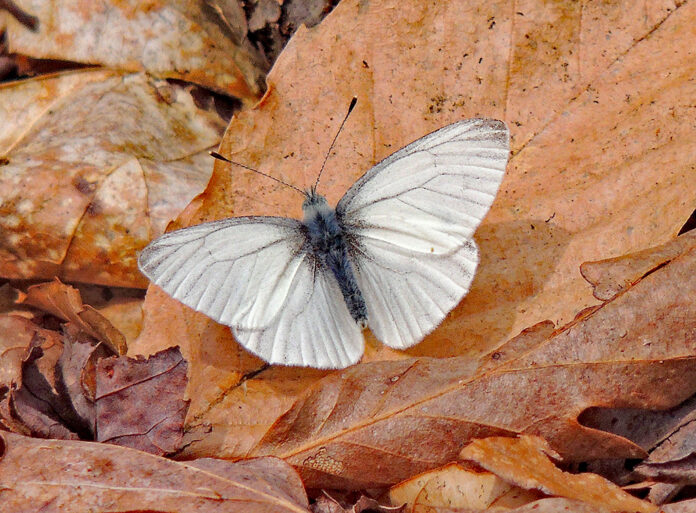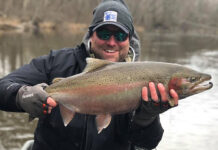As I sit typing this, a small, white, nondescript butterfly is on the wing throughout pristine woodland habitats across areas of the northeastern United States. For a brief window of time, usually falling somewhere between late March and mid-May (depending on temperatures), the West Virginia white (Pieris virginiensis) makes its tiny mark upon the world.
Emerging

So fleeting is this butterfly that most people fail to even notice it, much less recognize its existence. As temperatures rise and the sun’s rays reach down to warm the moist forest floor, a cryptically colored chrysalis, tucked in place since the previous spring, divulges its contents in the form of a dainty butterfly with a 1-inch wingspan.
Appearing pure white at first glance, one need only look closer to see the hundreds of delicate gray scales which highlight the venation of its wings. Even closer examination reveals the tiny orange, sickle-shaped marking on the underside of each lower wing, its vivid pigment a telltale sign of the Pieris family of butterflies.
In the safety of the warming woods, the West Virginia white sails weakly across the forest floor scarcely attaining a height much higher than 5 feet from the ground and never venturing out from beneath the forest canopy.
It stops frequently to nectar on the spring wildflowers: first a spring beauty, then a purple cress, a violet and so on. If luck is on its side, it will encounter a like individual of the opposite sex and the two of them will engage, spiraling round and round each other in a delicate dance until they hook up in a sharing of genes.
Parenting
Shortly after mating, the female concentrates on her new job, seeking out the primary host plant on which to deposit her eggs — Cardamine diphylla, often referred to as two-leaved toothwort. With renewed determination, she skims across the woodland vegetation seeking out the toothwort and depositing a single egg on the underside of a leaf on each plant she encounters. In less than 3 weeks, her short flight season complete, she perishes.
Now begins a race against time. Within three days, the eggs hatch, and tiny green caterpillars begin to munch their life-giving host. As the leaves break from their buds in the deciduous trees above, they hinder the sunlight from reaching the ground, and the spring ephemerals begin to die back and disappear, dooming any caterpillars that haven’t yet matured.
As their host plants fade, the larvae make their way into a sea of leaves and twigs. They search for the perfect sheltered spot containing a structure on which they can form a chrysalis. The fresh pupa is green at first, blending in with the surrounding vegetation and then slowly turns a cryptic color to match the browning forest floor. And here the chrysalis will remain until the following spring, when the cycle of this butterfly will begin again.



In decline
During my tenure with Geauga Park District, I spent many a spring conducting surveys of the West Virginia white butterfly in order to pinpoint its remaining strongholds in the county as well as documenting the yearly status of each isolated population.
Sadly, this species is spiraling out of control in a precipitous decline due to a multitude of threats from which it can’t escape. Forest fragmentation, which occurs when roads or trails are cut through sizeable tracts of forest in order to open them up to development, is playing a large role in the future demise of this species.
Under the safety of their forest canopy, West Virginia whites are hesitant to move into open areas, the roads interfering with their dispersal and acting as a barrier against their movements into new habitats which might support their needs. Furthermore, logging operations, which play a role in many of these road projects, also contribute to the destruction of the wildflowers important to the West Virginia white.
To make matters worse, the overpopulation of white-tailed deer in many of the areas where the butterfly persists is creating a negative impact with their destructive browsing activity. Deer can and do drastically reduce the native understory, nearly, extirpating many spring wildflowers including trillium and toothwort while altering entire woodland ecosystems.
Biggest threat

Yet of all the threats that this butterfly faces, the most destructive is that of garlic mustard (Alliaria petiolata). This non-native, invasive herb was introduced by the Europeans in the mid-1800s, taking hold and growing rampant without anything to temper its spread.
As the plants multiply, they choke out nearly everything beneath them, forming a monoculture wherever they have space to do so and altering the entire forest ecosystem. Far worse, the garlic mustard contains a chemical called “sinigrin” which is also present in toothworts. The butterflies, sensing this compound, are tricked into thinking that the garlic mustard is in fact their host plant, laying eggs on its leaves. Tragically, once the caterpillars hatch, they are unable to survive.
Curious

After years of conducting my annual spring surveys of the West Virginial whites, my curiosity got the best of me. As a lover of lepidoptera, having raised a multitude of species of both butterflies and moths throughout my life, I just had to rear a few specimens of this declining species in an effort to witness their life cycle first hand.
I can only imagine how I must have appeared, clumsily chasing behind a female as she flitted along through the forest, dropping an egg here and there onto a hidden toothwort plant. From a distance, I would try to memorize which plant she had just visited, rushing up to it after her departure while trying to keep one eye on her to see where she traveled next.
As I examined the underside of the toothwort leaves, sometimes I was lucky enough to spot an egg, but most of the time I wasn’t. Usually, I lost sight of the female during this scrutinization and had to traipse around until I found another that was actively ovipositing.
At the end of many hours, I finally had about a dozen eggs. I dug several two-leaved toothwort plants and potted them up. This way, I could keep the leaves fresh for the newly emerged caterpillars which made their appearance shortly thereafter and grew amazingly fast. In less than a month, they had dropped off the toothwort and secured themselves to sticks that I had provided for them.
The ensuing chrysalises were incredible, their unique shape and coloration so unexpected. Starting off a stunning lime-green color, they eventually faded into different shades of browns and tans. Their life cycle complete, there was nothing left to do but find a safe way to store the chrysalises until the next year. And just like clockwork, on a warm, sunny day the following April, the butterflies emerged, as if on cue, giving me the opportunity to observe their beautiful markings up-close and personal.
I feel extremely lucky to have been a part of this little butterfly species’ existence and to witness its metamorphosis first hand. Obviously, this isn’t something that the average person will get to experience, but you can get out and see this special little butterfly before it disappears perhaps forever.
Simply take a walk in a woodland ravine rich in wildflowers. On a calm, sunny day in April or early May, move slowly, tread softly and look carefully across the forest floor and you just might be lucky enough to spot the movement of a small white butterfly — a fading forest gem — as it struggles to maintain its presence in our world.














